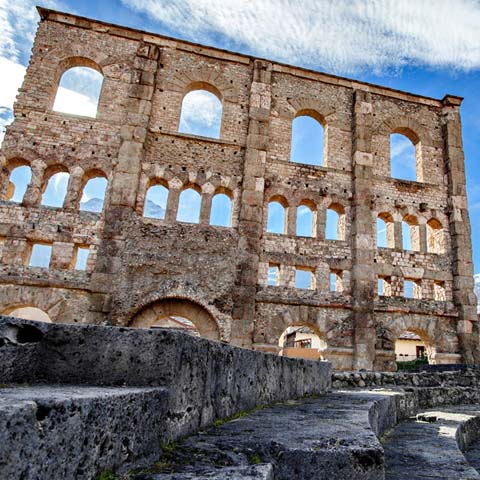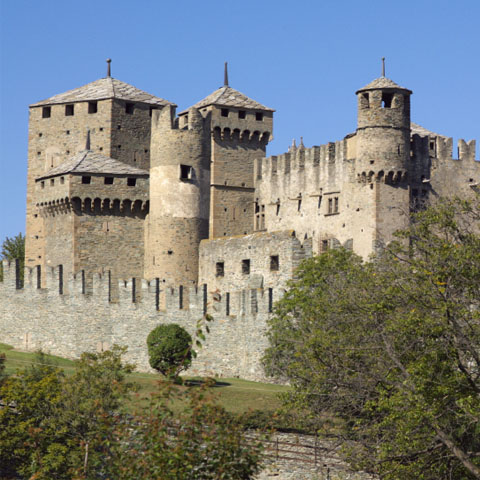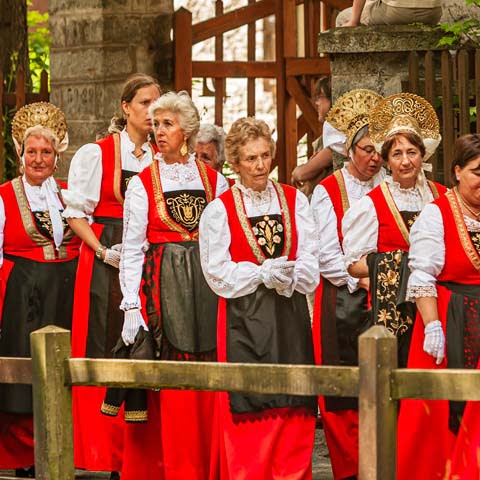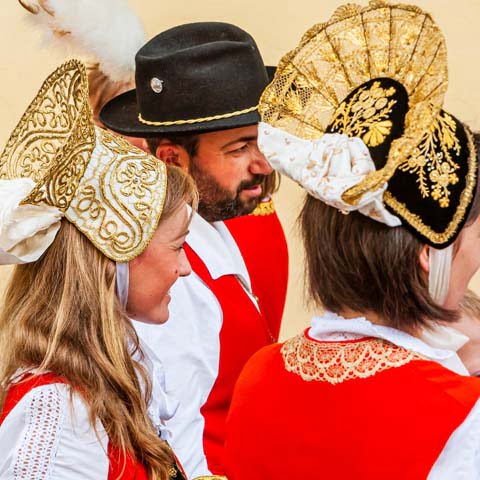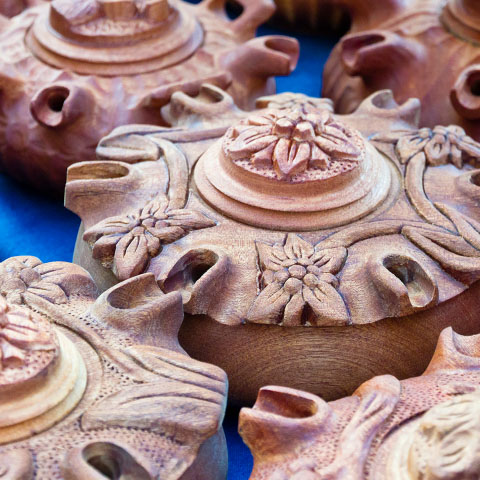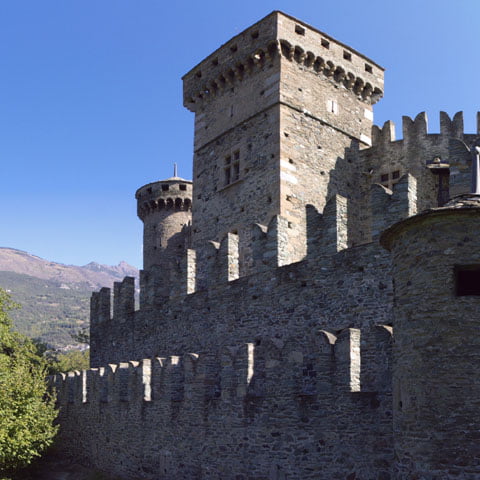Aosta is a paradise for skiers and hikers and is the regional capital of the Aosta Valley of Italy. The town is located in a flat basin surrounded by a spectacular amphitheater of glaciers and alpine peaks in the upper Dora Baltea Valley. The Gran Paradiso National Park, featuring an alpine botanical garden, hiking trails and rare wildlife is located near the city and is a favorite attraction of locals and travelers alike.
The old town was erected on the urban layout of a Roman settlement, organized with orthogonal axes that extend outside of the rectangular city walls. The medieval city walls are largely preserved and are one of the main attractions of Aosta.
Some of the twenty square-shaped towers distributed along the walls remain in excellent condition and still watch over the town and the valley. The marvelous medieval boroughs of Ponte di Pietra, Saint- Étienne and Sant’Orso can be seen outside of the old town’s perimeter, featuring alpine houses with slate roofs.
The modern city has expanded with residential districts, especially towards the north and south. To the south there is an industrial area, as well as a railway line connecting Aosta with the rest of Italy.
PREHISTORY OF AOSTA
The accidental discovery of the megalithic area of Saint-Martin-de-Corléans in 1969 documents the prehistoric origins of the city. The archaeological site was subject to systematic excavations up to 1990, and numerous artifacts dating back to about 3000 BC were discovered.
It was established that at the time, the Salassi Celtic tribes inhabited the Aosta Valley. Settled in Cordelia, a settlement whose traces have been lost, these peoples dedicated themselves to pastoralism and crafts for centuries. Protected by the natural bulwarks, the tribes developed independently until Rome gained a strategic interest in the territory.
The Roman invasion that occurred in the second century BC was violent. The Salassi fought for their land and won the first battle. But Rome sent stronger troops and managed to conquer the territory, dispersing the locals.
The Roman expansion towards new territories brought infrastructure to Aosta. The remains of two important roads can still be seen today. One road in the direction of Elvezia, which is today’s Switzerland, stretched towards St. Bernard, and the other road stretched toward Gallia.
But the Roman conquest did not eradicate the Salassi, and the Roman garrisons set up in Eporedia and Aosta were not enough to contain their incursion into the territory. The tribe rose up to reconquer their land, and in 25 BC the Emperor Augustus decreed the complete destruction of the Salassi, sending the legions of Aulus Terentius Varrone Murena to complete the mission.
The mission was completed with success, and over 36,000 Salassi were sold as slaves, and Murena established the colony of Augusta Praetoria Salassorum, today’s Aosta, in 24 BC.
From those times, the city still features the orthogonal Roman plan, with largely preserved city walls, some of the square towers and the Porta Pretoria gate. These vestiges are preserved in a perfect state of conservation, but are not the only remains from ancient times.
HISTORY OF AOSTA
The history of Aosta begins with the establishment of Augusta Praetoria Salassorum. The city was populated by veterans of the Praetorian cohorts, hence its name, and it maintained a strategic importance over the centuries, both from a military and economic point of view. Under Roman rule, the city received its symbol, the Arch of Augustus, erected a few years after the definitive conquest.
With the fall of the Roman Empire, Aosta passed under the Burgundians and followed the vicissitudes of the continuous struggles of those times between the Italian nobles and the German emperors. The Longobards, Goths, Franks, and the Marquises of Italy and Monferrato gradually took possession of the municipality’s lands until Umberto I Biancamano of Savoy conquered the Aosta Valley. The new lordship brought peace, but the agitations that troubled the valley, provoked by the arrogance of the local nobles, did not cease.
In 1191, Thomas I of Savoy granted the Charter of Val d’Aosta Freedoms, a set of laws that established that the sovereign could only demand taxes previously accepted by the taxpayers in an assembly. The Charter also decreed the roles of bailiff and deputy bailiff, two figures with exceptional powers in times of peace and war. These offices were only abolished in 1773.
As a result of the Charter, the Aosta Valley received an autonomous government organized in the Assembly of the Three States, in which the clergy, nobility and the people were represented.
In 1235, the Aosta Valley, including Aosta, was invaded and devastated by the Vallesans, but Amadeus IV of Savoy defended the region and defeated the enemy, pushing the Vallesans towards the pass of Saint Bernard and assaulting Sion, the capital of Valais. In 1238, Emperor Frederick II granted the rank of Duchy to the province of Aosta.
During the thirteenth century, the duchy was involved in the struggles between Kings Charles V and Francis I. Managing to conclude treaties of neutrality with both sovereigns, Aosta saved itself from the horrors of the conflict.
In 1536, to accelerate the exceptional deliberations resulting from the expulsion of the reformer John Calvin, the administrative authority established the Council of the Elected, which later transformed into the Council of the Clerks. The Council still consisted of the representatives of the three states, but gave the Savoy the right to personally intervene and listen to the complaints, break down dissent, or correct any mistakes committed.
The peace ended in Aosta in 1691, when the French troops invaded its territory. With a weak, almost inexistent military power, Aosta had to succumb and accept to pay tributes to France. The flourishing economy of the city suffered enormous damage and Aosta entered a period of decay. In the following century, things did not improve much. The French troops invaded the region again in 1703, and in 1704 the Forte di Bard passed under Swiss control.
The struggles ended with the Peace of Utrecht, signed in 1713, but this period of apparent peace only lasted until 1740. During the successive wars of Charles IV of Austria, Duke Charles Emmanuel III crossed the Aosta Valley with his troops, fighting against the Spaniards.
Twenty years later, in May 1800, Napoleon crossed the Alps, entered the region, and conquered both the valley and the city. Aosta became part of France and was included in the department of Dora. But Aosta Valley did not remain under French occupation for too long, and in 1815 it returned to the Savoy. In the upcoming events of the Risorgimento, the city showed fidelity toward the Italian rulers and was annexed to the Kingdom of Italy in 1861.
In the twentieth century, Mussolini tried to attenuate the spirit of independence of the region through a massive phenomenon of immigration of Italians from other regions. But the resistance movement of the inhabitants was very lively, with Aosta considering separation from Italy to rejoin France. As a result of the events, after World War II, the Aosta Valley was granted the special status of autonomous region, with Aosta becoming the regional capital.
The opening of the Mont Blanc tunnel in 1965 and the general improvements of the infrastructure transformed Aosta and the whole valley from a crumbling rural area into an important travel destination.
ARCHAEOLOGY IN AOSTA
Despite its small size, Aosta is rich in archaeological evidence. Remains of the Roman amphitheater are incorporated in the Convent of Santa Caterina, while the theater occupies an entire block of the Roman urban plan. These sites are among the most important Roman remains in Northern Italy.
Piazza del Duomo features remains of the Roman Forum, a temple, and a crypt, while the outskirts of the city have other well-preserved Roman vestiges, including a bridge over Buthier Stream and the massive Arch of Augustus built in honor of the emperor to celebrate the victory over the Salassi.
The city preserves interesting vestiges of the Middle Ages as well, including the Romanesque cloister of Sant’Orso, which is probably the most important monumental complex of Aosta. The extraordinary cloister was erected in the twelfth century and maintains its original charm despite the church being repeatedly reconstructed throughout the centuries.
In fact, the church was built on the remains of an early Christian basilica during the Carolingian period, then transformed into a Romanesque church with three naves and frescoed walls. In the fifteenth century, the church underwent important transformations that gave a Gothic aspect to the edifice. Nevertheless, some of the original Romanesque frescoes were preserved.
Next to the imposing Cathedral of Aosta is a magnificent cryptoporticus, an imposing semi-hypogeal structure that marks the end of the northern side of the old town, regulating the natural slope of the land. This double gallery with cellar vault originally enclosed a sacred area and represented an extension of the Forum’s portico. It served as a support for an arcade above the ground and, considering the proximity of the temples of the city, it is believed to have served ritual purposes as well. Some archaeological evidence suggests the subsequent use of the edifice as a warehouse.
Another suggestive edifice is an early Christian basilica observable from the cryptoporticus.
The Regional Archaeological Museum is extremely important from an archeological point of view. The museum’s halls are set up according to a thematic-chronological itinerary and hold suggestive artifacts. The itinerary covers a long period of time, from 7000 BC to the seventeenth century AD.
The exhibition begins with two important anthropomorphic steles discovered on the site of Saint-Martin de Corléans and features some fascinating protohistoric findings.
Inside the museum, an entire hall holds a large plan of Augusta Praetoria, while the exhibition continues with stunning findings including Roman furniture and other artifacts from the Roman era. Some of the most noteworthy artifacts are a funeral bed, remains of statues, various tools and objects, epigraphs, and furnishings.
A didactic and evocative reconstruction of the environments before and after the Roman era ends the exhibition, while the upper floors of the museum host interesting temporary exhibitions.
Also noteworthy is a large Roman villa located in the Consolata area of Aosta. This large urban-rustic villa is built at about 1,300 feet outside the walls of Aosta and its construction dates back to 25 BC. This suggests that it was probably a villa of a Roman dignitary who settled there at about the same time the foundations of the city were built.
The villa was transformed over the centuries, and in an attempt to erase the more modern works, the municipality obscured the interior, focusing on illuminating only the ancient structures.
The city towers are also important from an archaeological point of view. Erected by the Romans to watch over the valley and the city walls, they were transformed into residences for the local lords during the Middle Ages.
Don't just see Italy, live it.
Your dream trip to Italy has never been closer
No more endlessly scrolling travel sites. Our travel experts will craft the perfect, one-of-a-kind trip just for you.

300+
DESTINATIONS
We offer more Italian destinations than any travel site. Do and see more with Trips 2 Italy.
1 (of a kind)
ITINERARIES
Because your dream trip to Italy should be designed for you, not for the masses.
100%
PEACE OF MIND
From flights and accommodations, to food and activities - we take care of every detail.
